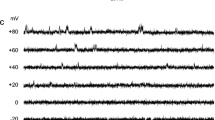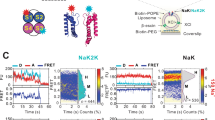Abstract
TREK-2 (TWIK-related K+ channel-2), a member of two-pore domain potassium (K2P) channel family, tunes cellular excitability via conducting leak or background currents. In TREK-2, the isoforms generated by alternative translation initiation (ATI) mechanism exhibit large divergence in unitary conductance, but similar in selectivity to K+. Up to now, the structural basis for this similarity in ion selectivity is unknown. Here, we report that externally applied Ba2+ inhibits the currents of TREK-2 in a concentration- and time-dependent manner. The blocking effect is blunted by elevated extracellular K+ or mutation of S4 K+ binding site, which suggests that the inhibitory mechanism of Ba2+ is due to its competitive docking properties within the selectivity filter (SF). Next, we demonstrate that all the ATI isoforms exhibit analogous behaviors upon the application of Ba2+ and alteration of extracellular pH (pHo), which acts on the outer position of the SF. These results strongly support the notion that all the ATI isoforms of TREK-2 possess resembled SF conformation in S4 site and the position defined by pHo, which implicates that neither the role of N-terminus (Nt) nor the unitary conductance is associated with SF conformation. Our findings might help to understand the detail gating mechanism of TREK-2 and K2P channels.





Similar content being viewed by others
Abbreviations
- TREK:
-
TWIK-related K+ channel
- K2P:
-
Two-pore domain potassium channel
- SF:
-
Selectivity filter
- ATI:
-
Alternative translation initiation
- Nt:
-
N-terminus
- pHo :
-
Extracellular pH
- KcsA:
-
Potassium channels from S. lividans
- Kv channel:
-
Voltage-gated K+ channel
- WT:
-
Wild type
References
Acosta C, Djouhri L, Watkins R, Berry C, Bromage K, Lawson SN (2014) TREK2 expressed selectively in IB4-binding C-fiber nociceptors hyperpolarizes their membrane potentials and limits spontaneous pain. J Neurosci 34:1494–1509
Berneche S, Roux B (2001) Energetics of ion conduction through the K+ channel. Nature 414:73–77
Brohawn SG, Del MJ, MacKinnon R (2012) Crystal structure of the human K2P TRAAK, a lipid- and mechano-sensitive K+ ion channel. Science 335:436–441
Cai J, Huang Y, Li F, Li Y (2006) Alteration of protein subcellular location and domain formation by alternative translational initiation. Proteins 62:793–799
Chang HK, Marton LJ, Liang KK, Shieh RC (2009) K+ binding in the G-loop and water cavity facilitates Ba2+ movement in the Kir2.1 channel. Biochimica et biophysica acta 1788:500–506
Chatelain FC, Alagem N, Xu Q, Pancaroglu R, Reuveny E, Minor DL Jr (2005) The pore helix dipole has a minor role in inward rectifier channel function. Neuron 47:833–843
Chatelain FC, Gazzarrini S, Fujiwara Y, Arrigoni C, Domigan C, Ferrara G, Pantoja C, Thiel G, Moroni A, Minor DL Jr (2009) Selection of inhibitor-resistant viral potassium channels identifies a selectivity filter site that affects barium and amantadine block. PLoS One 4, e7496
Cohen A, Ben-Abu Y, Hen S, Zilberberg N (2008) A novel mechanism for human K2P2.1 channel gating. Facilitation of C-type gating by protonation of extracellular histidine residues. J Biol Chem 283:19448–19455
Cordero-Morales JF, Cuello LG, Zhao Y, Jogini V, Cortes DM, Roux B, Perozo E (2006) Molecular determinants of gating at the potassium-channel selectivity filter. Nat Struct Mol Biol 13:311–318
Cordero-Morales JF, Jogini V, Lewis A, Vasquez V, Cortes DM, Roux B, Perozo E (2007) Molecular driving forces determining potassium channel slow inactivation. Nat Struct Mol Biol 14:1062–1069
Cuello LG, Jogini V, Cortes DM, Perozo E (2010) Structural mechanism of C-type inactivation in K(+) channels. Nature 466:203–208
Domene C, Klein ML, Branduardi D, Gervasio FL, Parrinello M (2008) Conformational changes and gating at the selectivity filter of potassium channels. J Am Chem Soc 130:9474–9480
Enyedi P, Czirjak G (2010) Molecular background of leak K+ currents: two-pore domain potassium channels. Physiol Rev 90:559–605
Jiang Y, MacKinnon R (2000) The barium site in a potassium channel by x-ray crystallography. J Gen Physiol 115:269–272
Kang D, Choe C, Cavanaugh E, Kim D (2007) Properties of single two-pore domain TREK-2 channels expressed in mammalian cells. J Physiol 583:57–69
Kozak M (2005) Regulation of translation via mRNA structure in prokaryotes and eukaryotes. Gene 361:13–37
Labro AJ, Snyders DJ (2012) Being flexible: the voltage-controllable activation gate of kv channels. Front Pharmacol 3:168
Lesage F, Terrenoire C, Romey G, Lazdunski M (2000) Human TREK2, a 2P domain mechano-sensitive K+ channel with multiple regulations by polyunsaturated fatty acids, lysophospholipids, and Gs, Gi, and Gq protein-coupled receptors. J Biol Chem 275:28398–28405
Lopez GA, Jan YN, Jan LY (1994) Evidence that the S6 segment of the Shaker voltage-gated K+ channel comprises part of the pore. Nature 367:179–182
Lotshaw DP (2007) Biophysical, pharmacological, and functional characteristics of cloned and native mammalian two-pore domain K+ channels. Cell Biochem Biophys 47:209–256
Lu NZ, Cidlowski JA (2005) Translational regulatory mechanisms generate N-terminal glucocorticoid receptor isoforms with unique transcriptional target genes. Molecular cell 18:331–342
Ma XY, Yu JM, Zhang SZ, Liu XY, Wu BH, Wei XL, Yan JQ, Sun HL, Yan HT, Zheng JQ (2011) External BA2+ block of two-pore-domain potassium channel trek-1 defines conformational transition in its selectivity filter. J Biol Chem.
Miller AN, Long SB (2012) Crystal structure of the human two-pore domain potassium channel K2P1. Science 335:432–436
Noel J, Sandoz G, Lesage F (2011) Molecular regulations governing TREK and TRAAK channel functions. Channels (Austin) 5
O’Connell AD, Morton MJ, Sivaprasadarao A, Hunter M (2005) Selectivity and interactions of Ba2+ and Cs+ with wild-type and mutant TASK1 K+ channels expressed in Xenopus oocytes. J Physiol 562:687–696
Ogielska EM, Aldrich RW (1999) Functional consequences of a decreased potassium affinity in a potassium channel pore. Ion interactions and C-type inactivation J Gen Physiol 113:347–358
Piechotta PL, Rapedius M, Stansfeld PJ, Bollepalli MK, Erhlich G, Andres-Enguix I, Fritzenschaft H, Decher N, Sansom MS, Tucker SJ et al (2011) The pore structure and gating mechanism of K2P channels. EMBO J 30:3607–3619
Rhen T, Cidlowski JA (2005) Antiinflammatory action of glucocorticoids—new mechanisms for old drugs. The New England journal of medicine 353:1711–1723
Sandoz G, Douguet D, Chatelain F, Lazdunski M, Lesage F (2009) Extracellular acidification exerts opposite actions on TREK1 and TREK2 potassium channels via a single conserved histidine residue. Proc Natl Acad Sci U S A 106:14628–14633
Simkin D, Cavanaugh EJ, Kim D (2008) Control of the single channel conductance of K2P10.1 (TREK-2) by the amino-terminus: role of alternative translation initiation. J Physiol 586:5651–5663
Stansfeld PJ, Grottesi A, Sands ZA, Sansom MS, Gedeck P, Gosling M, Cox B, Stanfield PR, Mitcheson JS, Sutcliffe MJ (2008) Insight into the mechanism of inactivation and pH sensitivity in potassium channels from molecular dynamics simulations. Biochemistry 47:7414–7422
Taglialatela M, Champagne MS, Drewe JA, Brown AM (1994) Comparison of H5, S6, and H5-S6 exchanges on pore properties of voltage-dependent K+ channels. J Biol Chem 269:13867–13873
Thomas D, Plant LD, Wilkens CM, McCrossan ZA, Goldstein SA (2008) Alternative translation initiation in rat brain yields K2P2.1 potassium channels permeable to sodium. Neuron 58:859–870
Wang DT, Hill AP, Mann SA, Tan PS, Vandenberg JI (2011) Mapping the sequence of conformational changes underlying selectivity filter gating in the K(v)11.1 potassium channel. Nat Struct Mol Biol 18:35–41
Zhou Y, Morais-Cabral JH, Kaufman A, MacKinnon R (2001) Chemistry of ion coordination and hydration revealed by a K+ channel-Fab complex at 2.0 A resolution. Nature 414:43–48
Zhuo RG, Liu XY, Zhang SZ, Wei XL, Zheng JQ, Xu JP, Ma XY (2015) Insights into the stimulatory mechanism of 2-aminoethoxydiphenyl borate on TREK-2 potassium channel. Neuroscience 300:85–93
Zilberberg N, Ilan N, Goldstein SA (2001) KCNKO: opening and closing the 2-P-domain potassium leak channel entails "C-type" gating of the outer pore. Neuron 32:635–648
Zuniga L, Marquez V, Gonzalez-Nilo FD, Chipot C, Cid LP, Sepulveda FV, Niemeyer MI (2011) Gating of a pH-sensitive K(2P) potassium channel by an electrostatic effect of basic sensor residues on the selectivity filter. PLoS One 6:e16141
Acknowledgments
We thank Professor Gail Robertson (University of Wisconsin-Madison Medical School, Madison, WI) for the pGH-19 plasmid.
Grants
This work was supported by grants from National Major Scientific and Technological Special Project for “Significant New Drug Development” (2014ZX09507-003), National Integrated Drug Discovery Technology Platform Foundation of China (2012ZX09301003-001), and the National Science Foundation of China Grants (31200797).
Author information
Authors and Affiliations
Corresponding authors
Rights and permissions
About this article
Cite this article
Zhuo, RG., Peng, P., Liu, XY. et al. The isoforms generated by alternative translation initiation adopt similar conformation in the selectivity filter in TREK-2. J Physiol Biochem 71, 601–610 (2015). https://doi.org/10.1007/s13105-015-0422-z
Received:
Accepted:
Published:
Issue Date:
DOI: https://doi.org/10.1007/s13105-015-0422-z




